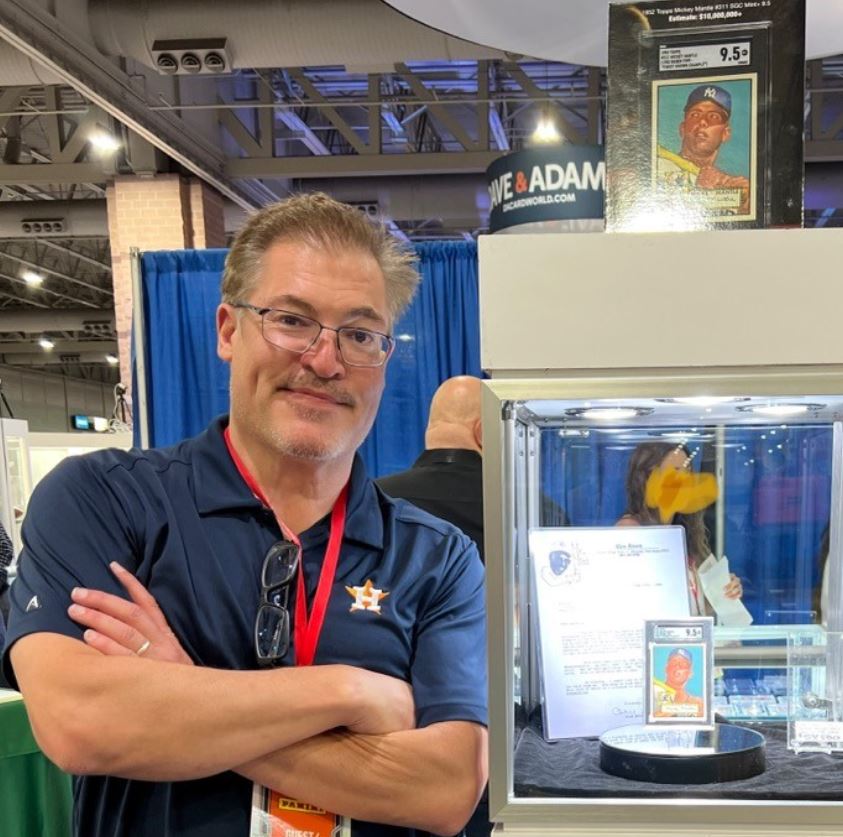Baseball is America’s Pastime. Baseball cards hold all of the major records for sports card collectors. The game has undergone many changes over time, but the reality is that a ballgame played in 2022 is really not all that different from a game that was played in 1922 or 1972. And baseball card collectors have been there the entire time. With a plunge in modern card prices and continued record prices for vintage cards, Collectors Dashboard wanted to highlight 7 vintage baseball cards that all collectors would want to own. This is actually the top 7 players and a review of their most sought after and available cards.
First and foremost, picking the top 7 is of course an opinion. Some people will completely disagree with at least one or two of these great players. All of the men are in the Baseball Hall of Fame. The rookie cards can cost more than even the top one-percent of the one-percenters is willing to pay for cardboard deities.
We have included specific cards for vintage collectors that are more widely available and/or which are more affordable. In fact, there are still generally cards of each of these great players (during their career) that are still obtainable by most collectors. This is also meant to keep some budgets in mind because vintage cards can rapidly go from hundreds of dollars to tens of thousands of dollars (or much more).
One quick admission here — these are only batters! No pitchers and no catchers. The top vintage card pitchers and catchers will be featured on their own. Whether or not these 7 players are ranked in order was not the case, at least not intentionally.
Follow on Twitter @CollectorsDash1 for more.
BABE RUTH
Being the original home run king with 714 homers is a major feat. Babe Ruth was a character on the field, and his off-field stories of drinking, smoking, eating and more even make the Babe Ruth story that much more colorful. Babe’s career might have been extended a year or two longer had he taken better care of his health and weight. His career batting average of .342 is stellar considering that most home run hitters are also big in strikeouts and long fly outs. Babe had 2,873 career hits and was walked 2,062 times, with a .690 slugging and .474 on-base percentage. There is so much more to say about the man who single-handedly ended the “Deadball Era” but that’s life.
If there is one vintage card that collectors would want to own, it has to be a card of Babe Ruth. Not the 1970s and 1960s cards of the Babe. Cards from his playing days. One serious drawback to owning any Babe Ruth card from his playing days is that any legitimate Babe Ruth card from his playing years will be a challenge to buy for under $1,000. And this also skips over Babe’s two variations of “rookie” cards because their costs are simply out of reach for almost anyone who will read this.
The one set that is perhaps the most iconic and most available is the 1933 Goudey set of Babe Ruth. And buying any of his 1933 Goudey cards for under $5,000 is a challenge unless they are in roadkill condition. There are four different Babe Ruth cards in the 1933 Goudey set. As of January 2022, the total graded population from PSA and SGC combined was only 6,994 graded cards. That is also a plentiful population for sets made almost 90 years ago and we have highlighted why these cards are actually the only reason that collectors can afford to buy real Babe Ruth cards in any condition at all. And while we said no pitchers were counted here, Ruth was actually a star pitcher at the start of his career.
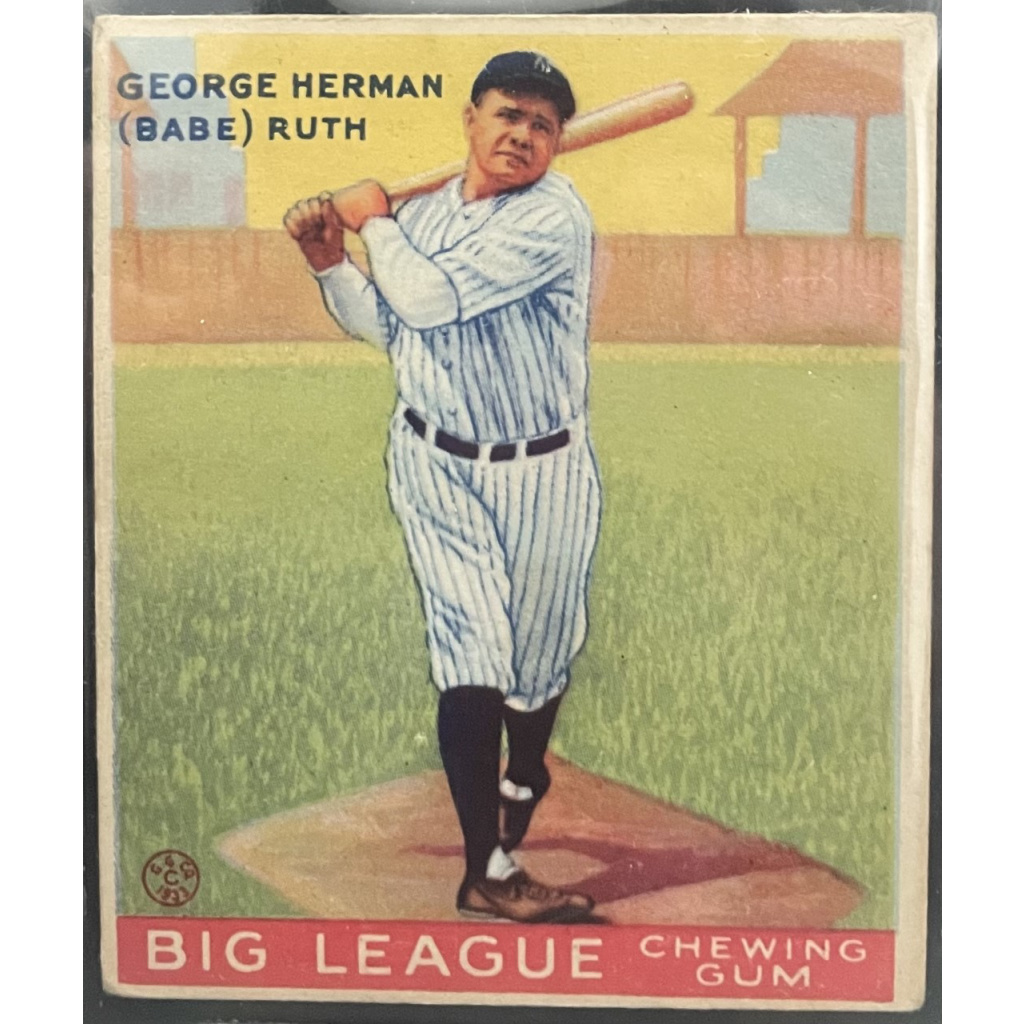
For some runner-up Babe Ruth baseball cards from his playing days, here are some alternatives that can still be considered “affordable” for vintage card buying on a budget.
1932 Sanella Babe Ruth is a German margarine card. It is larger in size than cards from the early 1900s and is larger than the cards produced today. It also featured Ruth batting, its image is stellar, and in some cases this card can still be purchased for $1,000 or less without being in roadkill condition.
1948 Leaf Babe Ruth. This card was produced right after Babe Ruth died and it is questionable to some collectors whether or not this should really be considered a legitimate Babe Ruth card as a result. That said, go find a collector who would be embarrassed to have this card.
1920s strip cards. The strip cards from the early 1920s were a way for collectors to buy a Babe Ruth card for under $1,000 up until recently. These cards have risen in value because of the fact that they were a cheap way to buy a Babe Ruth card and vintage collectors have to pay up for that right of ownership now. Just don’t ask about the visual presentation (a six year old kid today can draw an image of Babe Ruth better than some of the 1920s strip cards).
The 1929 WA & AC Churchman is visually stunning and can be found for under $1,000.00 in lower grades. There are questions about whether or not this should be considered a legitimate Babe Ruth card, but when you see the batting pose there is no doubt who the card is (it doesn’t actually say “Babe Ruth” anywhere on the card, and it was issued in the U.K.).
MICKEY MANTLE
Mickey Mantle is perhaps the face of vintage card collecting. The 1952 Topps issue is not even really his real rookie card, but the recent $12.6 million sale of this card shattered sales records for any sports collectible. Mantle still holds the record for World Series home runs. He racked up 536 home runs and his stat page shows that Mantle led the league in runs, triples, homers, walks, RBI’s, batting average, on-base percentage and slugging in at least one season. It’s an impressive feat.
The 1952 Topps card doesn’t have to cost you $12.6 million to own. That said, even a low-grade example can no longer be purchased for under $20,000 and the card is now becoming difficult to find even under $50,000. PSA’s graded population was 1,849 cards on last look with another 592 graded examples counted in SGC’s population reports. That’s a fairly large population but people who buy it tend to hold on to these cards for quite some time.
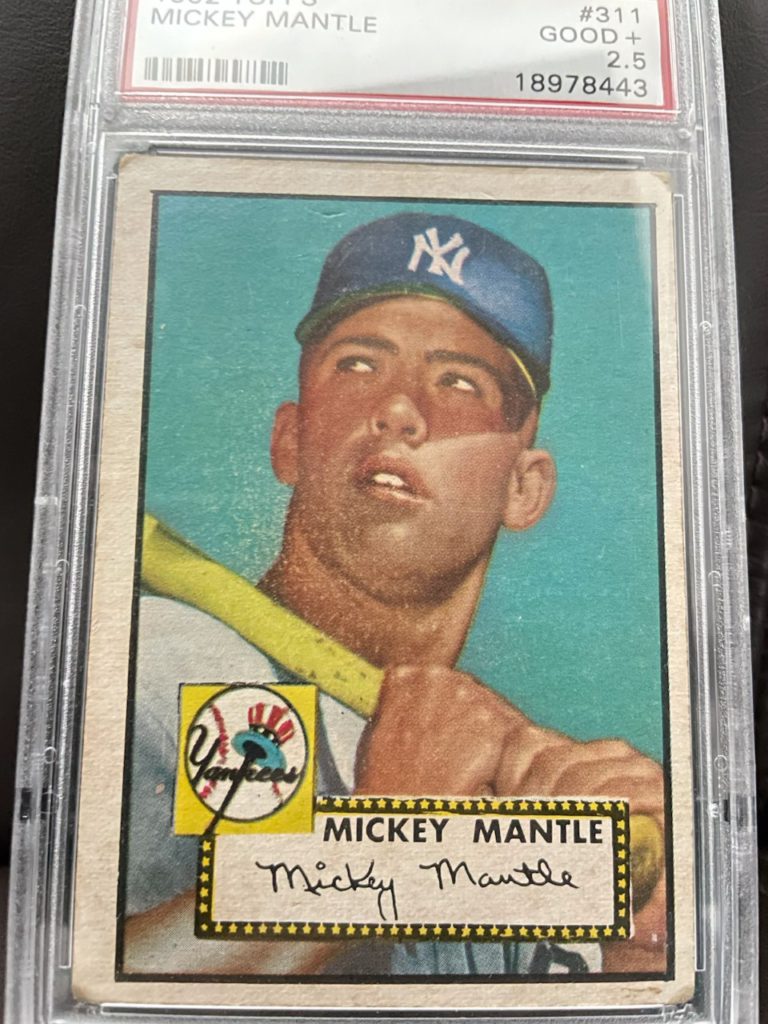
The 1951 Bowman card of Mickey Mantle is his true rookie card. The card has also seen its prices surge, but it is drastically more affordable than the 1952 Topps card in the same grade. The PSA population report currently counts 2,510 graded examples and SGC counts another 752 graded examples.
Any Mantle card from the 1950s is desirable in a vintage card collection. The 1953 Topps card has to be next on the list as well as the smaller 1952 Bowman card, with the latter’s relative affordability a bit difficult to explain and justify.
Bowman’s exclusive deal with Mantle in 1954 and 1955 means there are no cards after 1953 until 1956. The 1957 Topps card is the first full photo card by Topps (Bowman has a color photo card in 1953), and Mantle’s cards of the 1950s and 1960s are generally the most expensive cards of each set outside of rookies in those years. Mantle cards can still generally be purchased for easily under $500 in VG condition from his 1960s cards, and there are also All-Star and multi-player cards that can be owned.
HANK AARON
Owning the next Home Run King of Hank Aaron is a must for vintage baseball collectors. You can question whether or not Aaron’s home run record really matched up to Babe Ruth’s record or not (Babe’s was way more impressive actually than Hank’s 755 homers). But Hank Aaron has the be second on the list. The 1954 Topps Hank Aaron can be quite pricey, but cards graded PSA 1 can still be purchased for around $2,000 or so. Still, Hank Aaron may be the next card to break above the $1 million gavel price.
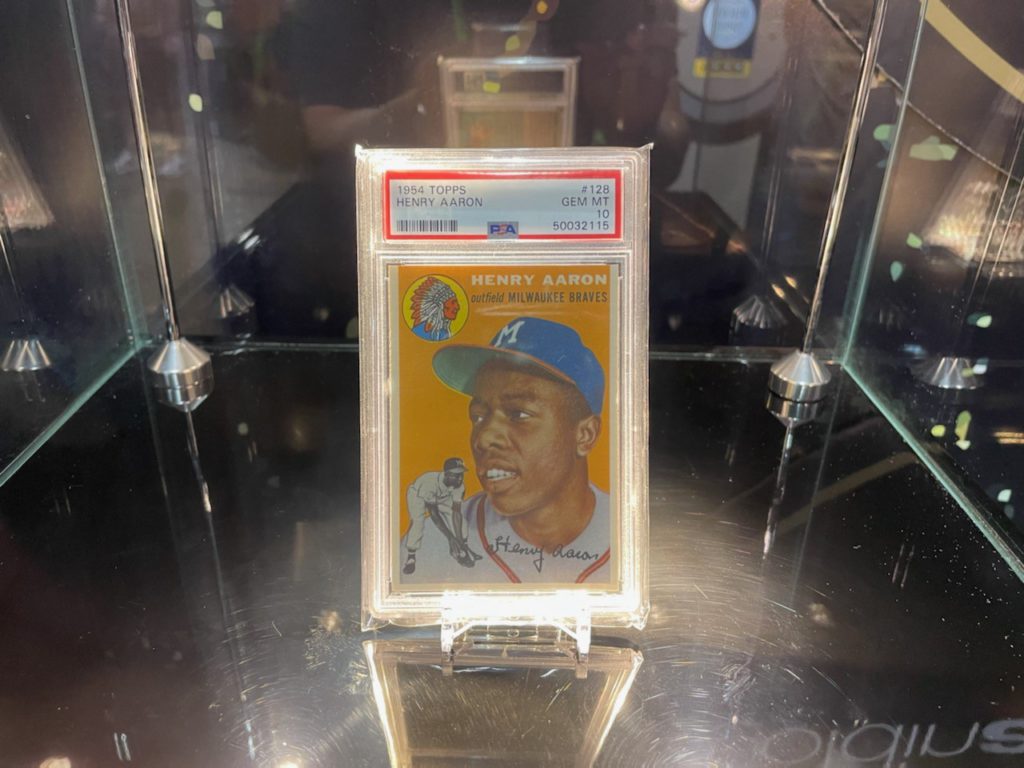

Several other Hank Aaron cards are much more affordable for vintage collectors than his rookie card.
The 1955 Topps card of Aaron is visually stunning, and its bright yellow presentation will make the image of Hammering Hank stand out from any other card issued by Topps in his playing years. The card is still quite affordable considering the importance of the issue.
The 1957 Topps Hank Aaron was the first year that Topps went to photo cards and it was the first year that the larger format cards were shrunk down to modern era standards. This card is also visually stunning, and it is actually an error card — look at the image and you will see why (hint: it’s a reverse image!).
Any of the 1960s Hank Aaron cards from Topps are still affordable from the 1960s, and like Mays (below) even more so for the 1970s Hank Aaron cards.
And for the best buys on a budget… The 1974 Topps card (#1 in the set) of Hank Aaron proudly displays Hank Aaron as the All-Time Home Run King. Its bright smiling image of Hank Aaron should have been of Hank swinging for that homer, but that’s life. This card can easily be purchased for under $100.00 in ungraded condition. It is perhaps an easy introductory card for vintage collectors getting started. Topps also printed Hank Aaron cards showing all of the base Topps cards (no All-Star cards) of his entire career as the Hank Aaron Special in cards #2 thru #6 in the set, and these cards are even cheaper to buy than the New All-Time Home Run King card.
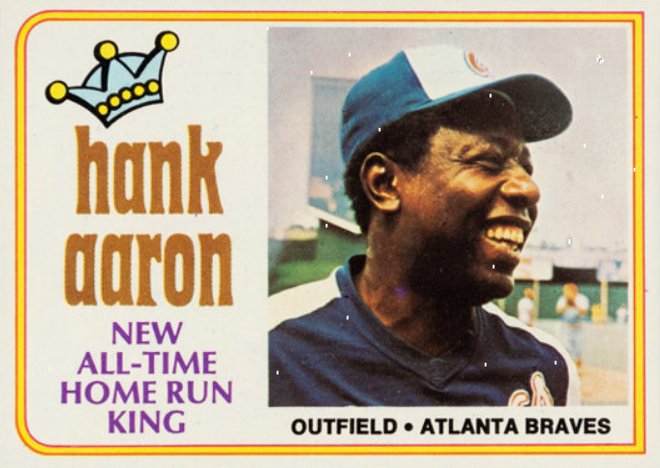
WILLIE MAYS
Willie Mays is generally not a more valuable card than Mickey Mantle. That said, Mays was actually a better player than Mantle if you break down each of his stats. Mays also played several more seasons than Mantle as he was a healthier player and abused his body less than Mantle. He racked up 3,293 career hits, had 660 home runs, had 1.909 RBIs and ended with a career .301 batting average. Perhaps a less known issue about Mays is that he was the highest salaried MLB player of the 1960s.
The 1951 Bowman Mays card and the 1952 Topps Mays card may be in a dead tie for vintage card collectors. The 1951 Bowman card is obviously his rookie card, but collectors just love that 1952 Topps issue perhaps more than any other set ever made. Both cards are now costly, even in a PSA 1 or PSA 2 grade. This image from Heritage Auctions.
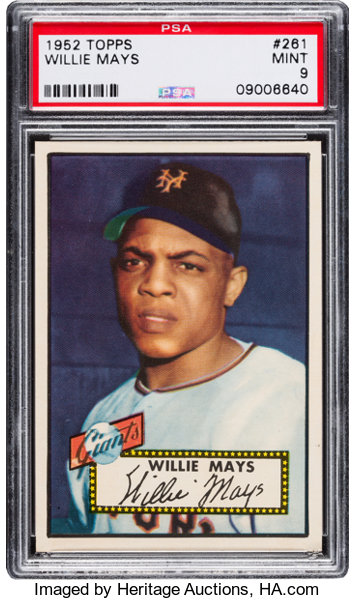
The 1953 Topps card of Willie Mays is a short print card that actually has a low population relative to some of the other star cards back then. Bowman did not have a Mays card that year and it was almost the case (due to military service) that this card could have been skipped from production because he only has 34 games from the season. Topps even complimented Mays with a note on back saying “One of the big reasons for the failure of the Giants to repeat their pennant-winning ways in ’52 was the loss of Willie to the Service early in the campaign.” And the artwork (image by Leland’s) from this card may be among the highest Mays sales to ever take place.
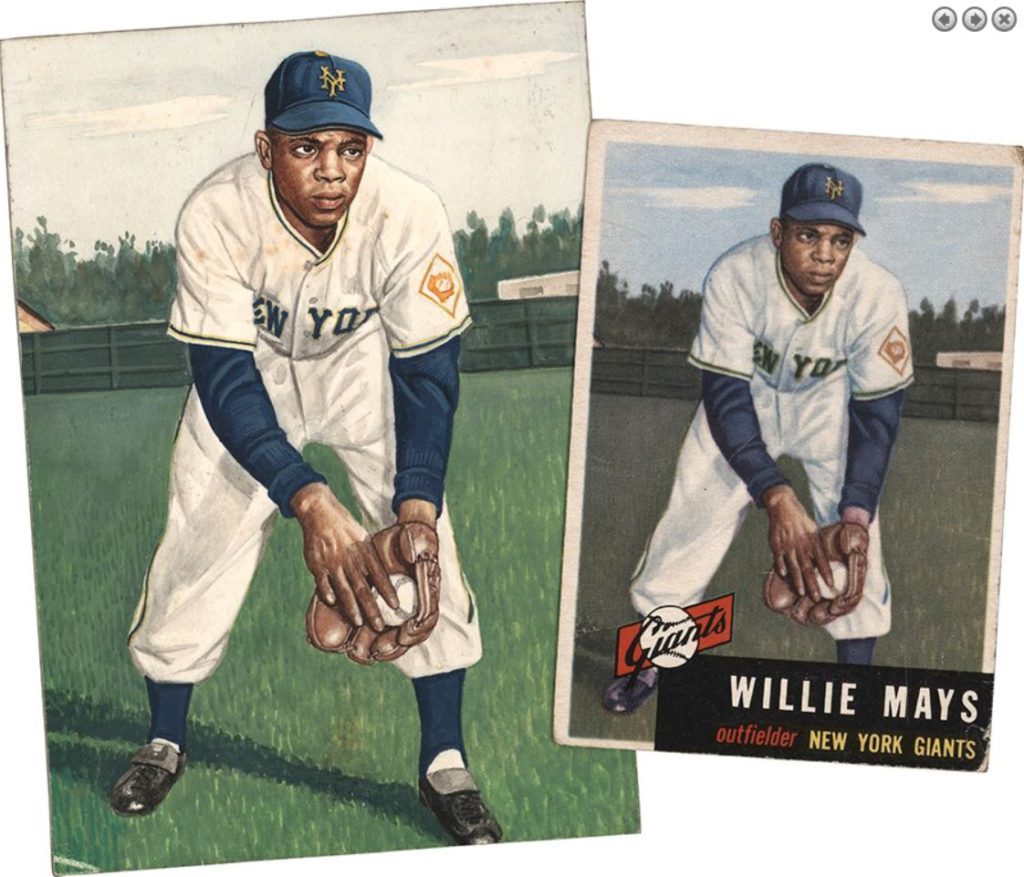
Long and short of the matter — ANY Willie Mays card from the 1950s is a relative home run of its own accord for vintage collectors. Visually speaking, the strong blue background of the 1955 Topps Mays stands out above and beyond the other years, but the 1954 and 1956 Topps Mays cards are desirable cards as is the 1954 Bowman card. And Mays cards of the 1960s are also still quite affordable for vintage collectors on a budget. That’s even more so the case for Mays’ Topps cards from the 1970s.
TY COBB
Most baseball historians would agree that Ty Cobb was one of the least popular players among his peers. They also cannot deny just how great of a player Ty Cobb was. What’s more impressive here — 4,189 hits; a .366 career batting average; 2 seasons in a row of .400 batting averages; never batting under .300 in a full season; of 897 stolen bases. You decide. Ty Cobb didn’t have any qualms about brandishing his metal spikes sliding into a base, although he himself tried to deny that in his own evaluation of his career.
If there is an iconic Ty Cobb issue, the T206 set from 1909 to 1911 had four different Ty Cobb cards. Pick your favorite – a red or green portrait, or two batting poses. Just get ready to pay up for these cards. PSA 1 cards are all still under $5,000 (except maybe for the green portraits), but Cobb cards are a major win for any vintage collector.
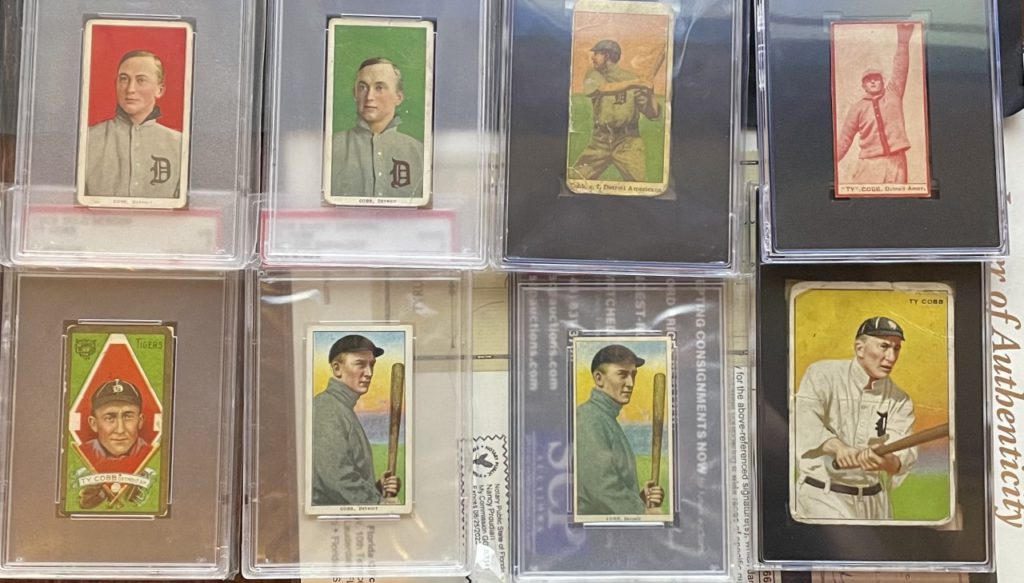
Here are some runner-up Ty Cobb cards that are perhaps a tad more affordable.
1920s strip cards. Like Ruth, these are all ugly drawing that most kids could draw better. They can also be found for around $1,000 (or less). Most are crude hand-cut cards (hence the strip).
The 1911 T201 Mecca Double Folder card is also still an affordable purchase for Ty Cobb. They can be purchased for under $1,000 if they are ungraded or in lower grades, but the big complaint here is that the front of the card (and the much larger image) is of teammate Sam Crawford). His image on the back also is not all that visually stunning. But it’s still a Ty Cobb card!
JACKIE ROBINSON
Jackie Robinson’s MLB career is perhaps the most famous of all players due to Robinson breaking the color barrier. All baseball teams have Robinson’s Number 42 as a retired number. One issue that keeps Robinson’s career stats less impressive is that he was 28 in his rookie year with the Brooklyn Dodgers. Robinson also hung up his cleats at the age of 37 when the Dodgers snuck out of Brooklyn to move to Los Angeles. If Robinson had a full MLB career from age 21 or 22 until age 40 or more he would have certainly had stronger numbers than 1,563 career hits. He finished with a .313 career batting average and he led the league in stolen bases twice.
The 1948 Leaf card of Jackie Robinson is a massive win for vintage card collectors. It has risen in price and the card’s yellow background presentation in higher grades is generally night and day when comparing to lower graded examples. Leaf had many printing issues that impacted this set, and quality control seemed to be non-existent.
The 1950 Bowman Jackie Robinson card is visually stunning, perhaps more so than any other card showing Robinson in-action. This card may be less valuable than the 1949 Bowman issue as the card company’s first ever card of Jackie), but the 1949 set’s image quality is not exactly full of the greatest eye appeal.
The 1952 Topps card of Jackie Robinson is a card most vintage collectors have a hard time walking away from (Image by Collectable). This high-number issue has also risen in value handily and is actually more scarce than the 1952 Topps card of Mickey Mantle. The PSA total graded population is just 1,300 examples, and GSC’s total population is just 317 graded examples.
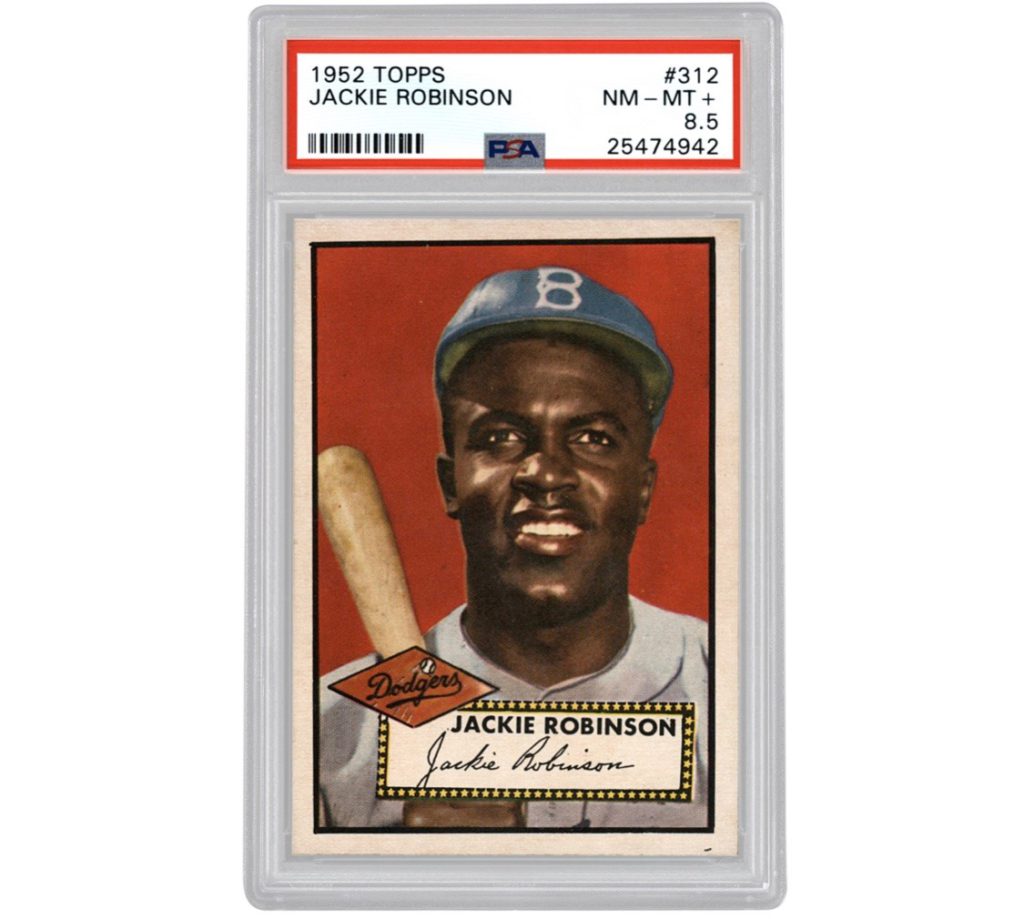
All 1950s Topps cards of Jackie Robinson are desirable. The 1953 Topps is next on the list by price, but the 1954, 1955 and 1956 issues are wins for any vintage collector. One issue that is generally overlooked or forgotten about is the 1955 Topps Double Header card of Jackie Robinson, which also features teammate Don Hoak upside-down on the back.
![]()
TED WILLIAMS
If there is one underrated batter in history, it’s Ted Williams. He may even be the greatest hitter to ever play the game. His batting feats would be far greater had he not lost the equivalent of nearly five baseball seasons due to World War II and the Korean War. Teddy Ballgame has many legendary stories on and off the field. He also wasn’t exactly loved by sports writers and baseball fans, also by his own doing. Ted was the last player to have a .400 batting average in a season. Ted still managed to hit 521 home runs, he had a career .344 batting average; his .482 on base percentage is still a record; and the only years he wasn’t on an All-Star team were when he was wearing a military uniform.
Perhaps the number-one Ted Williams baseball card is the 1939 Play Ball (#92) card. The black and white image and the smaller format of the set make the card “less than stunning” to look at but it does show Ted’s pose as a staged swing. PSA’s entire population of this card is just under 2,000 graded examples, and SGC’s graded population of the card is only 421 graded examples. There are technically three variations of the card (upper case, regular case, and a “sample” card issued ahead of time).
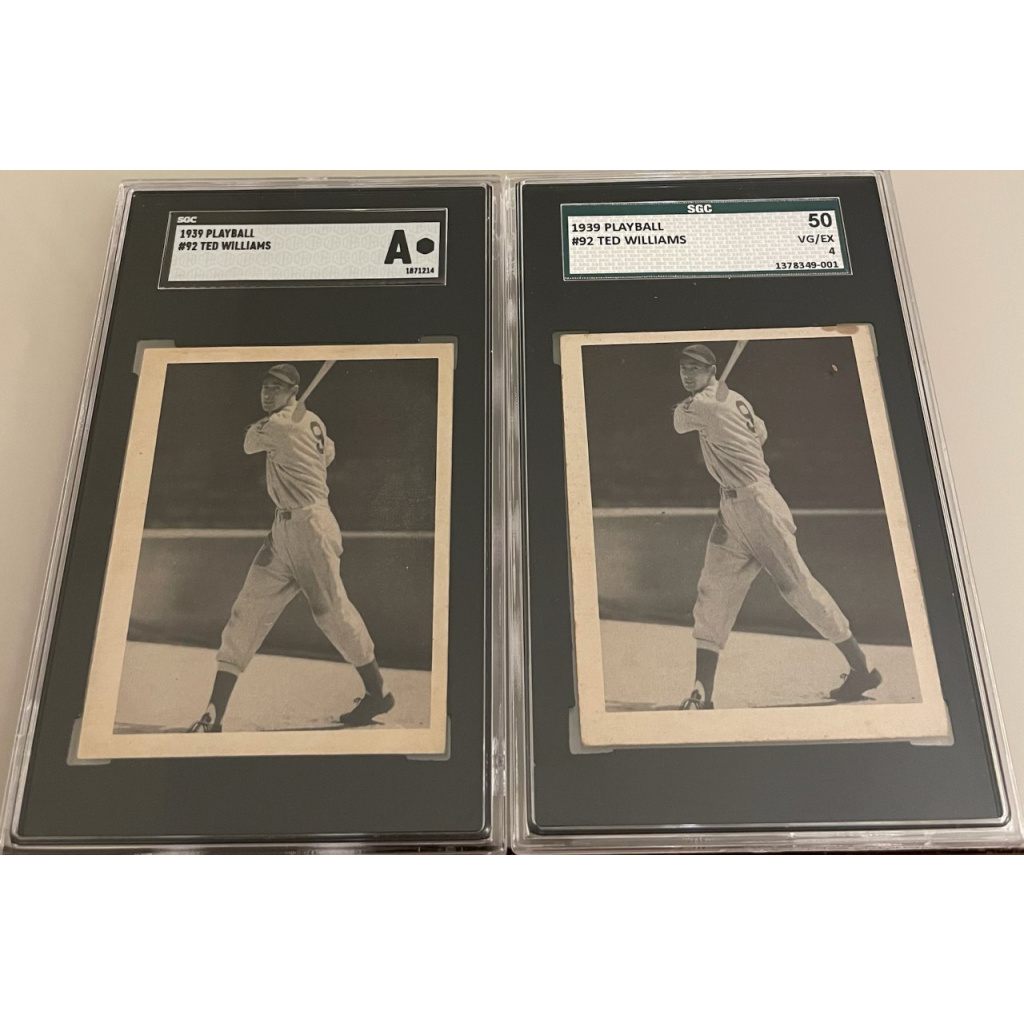
The reality is that there are many Ted Williams cards for vintage collectors to choose from. The 1959 Fleer set of Ted Williams may have flooded the market with Ted Williams cards, and this may have acted as a price-cap on a player that may otherwise be much more expensive. Those 1959 Fleer cards can be quite affordable (some under $100 still).
1950 and 1951 Bowman — it’s the same image, but in different sizes and a different cut. It was Bowman’s first cards of Ted despite the 1949 and 1948 card sets.
1954 Topps, with the only major issue of Ted Williams having the first card in the set and the last card in the set. These are not difficult to find as a result. Pick your color as well – yellow or orange!
1948 Leaf also shows Ted batting. The card has a sharp visual presentation with a red background (even in the pink or magenta variations).
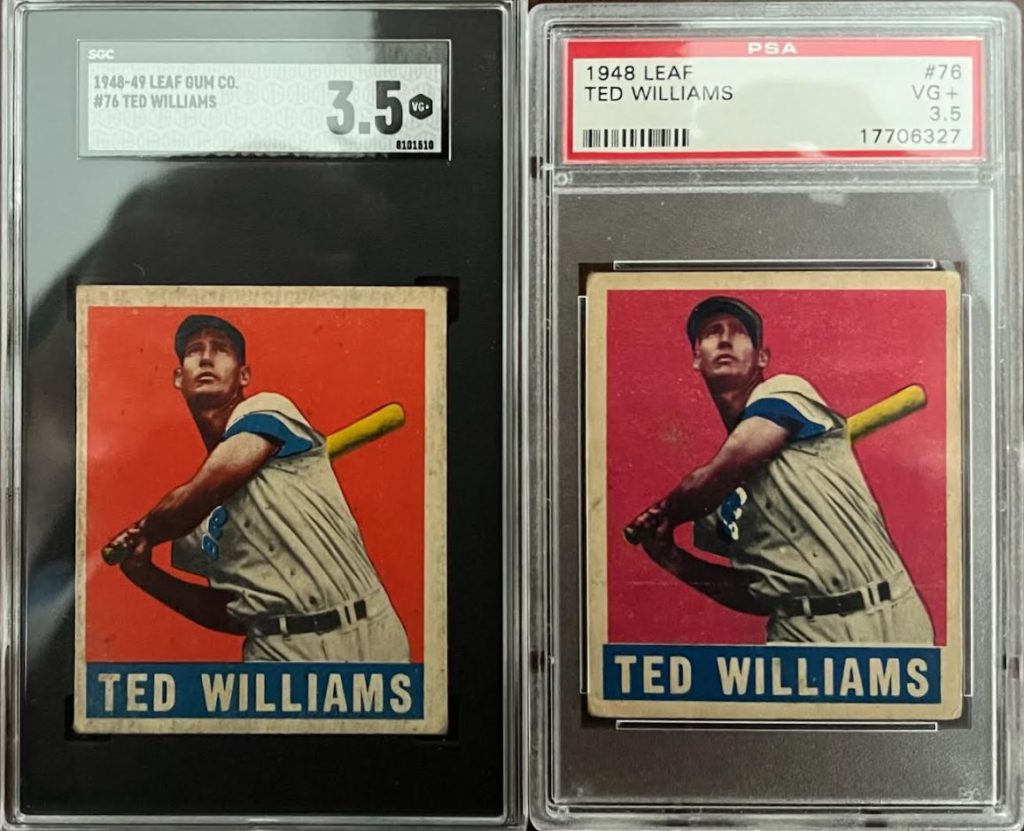
The 1954 Bowman card of Ted Williams was pulled from production because Ted had signed an exclusive with Topps (and card #66 was replaced by Jim Piersall – who?). This card is considered more scarce than other Ted Williams cards, although perhaps not as scarce as previously thought with a total graded population 1,275 examples by PSA and 377 graded examples by SGC.
BUT WHO ELSE?????
This is a hard admission to make after featuring the top 7 baseball players for vintage card collectors. Again, the list did not count any pitchers nor any catchers either. And it only focused on offense stats (not even “The Catch” by Mays!). And this list also gives a huge advantage to players from the 1950s versus those who started playing in the 1960s and 1970s or those who were featured on tobacco cards more than a century ago.
As for other baseball greats… Stan Musial, Roberto Clemente, Joe DiMaggio, Lou Gehrig, Honus Wagner, Nap Lajoie, Shoeless Joe Jackson and many more players should also be given full features as well.
Follow on Twitter @CollectorsDash1 for more.
